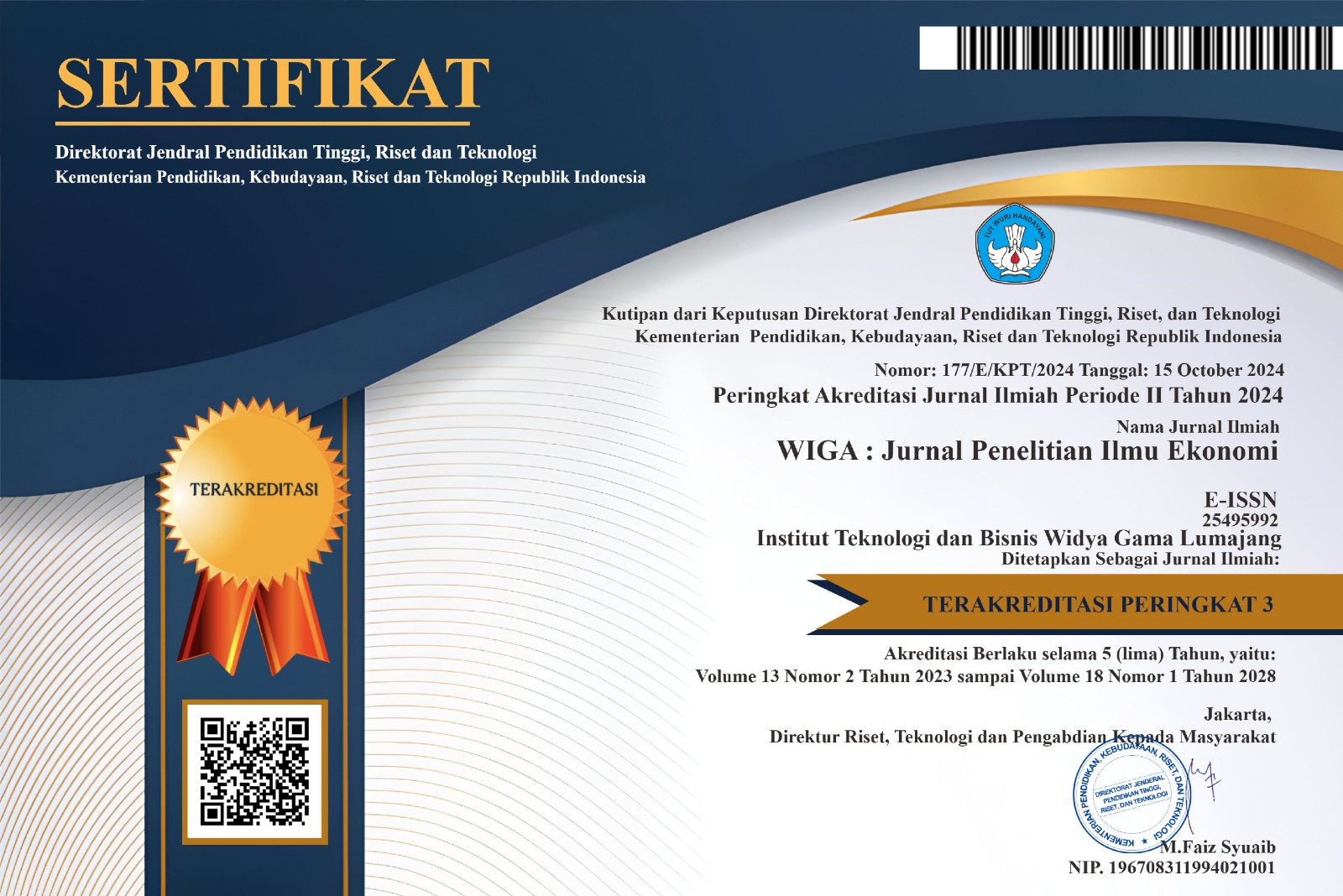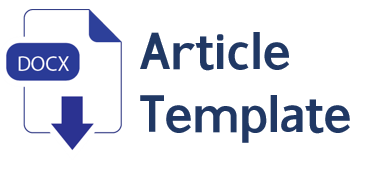The Role of Social Media Adoption and Dynamic Capabilities to Boost SMEs Performance: A Moderated Analysis
DOI:
https://doi.org/10.30741/wiga.v12i3.863Keywords:
Social Media Adoption, Dynamic Capabilities, Market Orientation, SMEs PerformanceAbstract
The objective of this study is to examine and analyze the direct influence of social media adoption and dynamic capabilities in increasing SMEs performance. It also considers market orientation as a moderating variable to understand more about the condition by which the relationship between the variables can be strengthened or weakened. By using quantitative approach, this study focuses on culinary SMEs in Bandung, West Java. The number of samples is 300 respondents, and the data is collected through giving questionnaire using Google Forms to culinary SMEs actors. The findings of this study indicate that both social media adoption and dynamic capabilities have a positive influence on SMEs performance. Furthermore, this study also prove that market orientation can strengthen the relationship between social media adoption and SMEs performance, as well as dynamic capabilities and SMEs performance. Finally, several implications are pointed out for both practitioners and scholars.
Downloads
References
Ahmad, S. Z., Bakar, A. R. A., & Ahmad, N. (2018). Social media adoption and its impact on firm performance: the case of the UAE. International Journal of Entrepreneurial Behavior & Research, 25(1), 84-111. https://doi.org/10.1108/IJEBR-08-2017-0299
Ainin, S., Parveen, F., Moghavvemi, S., Jaafar, N. I., & Shuib, N. L. M. (2015). Factors influencing the use of social media by SMEs and its performance outcomes. Industrial Management & Data Systems, 115(3). 570-588. https://doi.org/10.1108/IMDS-07-2014-0205
Arend, R. J. (2013). Ethics-focused dynamic capabilities: A small business perspective. Small Business Economics, 41(1), 1–24. https://doi.org/10.1007/s11187-012-9415-2
Bakri, A.A.A. (2017). The impact of social media adoption on competitive advantage in the small and medium enterprises. International Journal of Business Innovation and Research, 13(2), 255-269. https://doi.org/10.1504/IJBIR.2017.083542
Barreto, I. (2010). Dynamic capabilities: A review of past research and an agenda for the future. Journal of Management, 36(1), 256–280. https://doi.org/10.1177/0149206309350776
Battisti, M., & Deakins, D. (2017). The relationship between dynamic capabilities, the firm’s resource base and performance in a post-disaster environment. International Small Business Journal, 35(1), 78–98. https://doi.org/10.1177/0266242615611471
Cacciolatti, L., & Lee, S. H. (2016). Revisiting the relationship between marketing capabilities and firm performance: The moderating role of market orientation, marketing strategy and organisational power. Journal of Business Research, 69(12), 5597-5610. https://doi.org/10.1016/j.jbusres. 2016.03. 067
Deshpandé, R., & Farley, J. U. (1998). Measuring market orientation: generalization and synthesis. Journal of market-focused management, 2(3), 213-232. https://doi.org/10.1023/A: 1009719615327
Deshpandé, R., & Farley, J. U. (1999). Executive insights: corporate culture and market orientation: comparing Indian and Japanese firms. Journal of International Marketing, 7(4), 111-127. https://doi.org/10.1177%2F1069031X9900700407
Eisenhardt, K. M., & Martin, J. A. (2000). Dynamic capabilities: what are they?. Strategic management journal, 21(10‐11), 1105-1121. https://doi.org/10.1002/1097-0266(200010/11)21:10/11%3C1105:: AID-SMJ133%3E3.0.CO;2-E
Eriksson, T. (2014). Processes, antecedents and outcomes of dynamic capabilities. Scandinavian Journal of Management, 30(1), 65–82. https://doi.org/10.1016/j.scaman.2013.05.001
Fainshmidt, S., Pezeshkan, A., Frazier, M. L., Nair, A., & Markowski, E. (2016). Dynamic capabilities and organizational performance: A meta-analytic evaluation and extension. Journal of Management Studies, 53(8), 1348–1380. https://doi.org/10.1111/joms.2016.53.issue-8
Fan, M., Qalati, S. A., Khan, M. A. S., Shah, S. M. M., Ramzan, M., & Khan, R. S. (2021). Effects of entrepreneurial orientation on social media adoption and SME performance: The moderating role of innovation capabilities. PloS one, 16(4), e0247320. https://doi.org/10.1371/journal.pone.02 47320
Garbellano, S., & Da Veiga, M. D. R. (2019). Dynamic capabilities in Italian leading SMEs adopting industry 4.0. Measuring Business Excellence, 23(4), 472-483. https://doi.org/10.1108/MBE-06-2019-0058
Groothuis, D. A., Spil, T. A. M., & Effing, R. (2020). Facebook Marketing Intelligence. Paper presented at the HICSS.
Hakala, H. (2011). Strategic orientations in management literature: Three approaches to understanding the interaction between market, technology, entrepreneurial and learning orientations. International Journal of Management Reviews, 13(2), 199–217. https://doi.org/10.1111/j.1468-2370.2010.00292.x
Hernández-Linares, R., Kellermanns, F. W., & López-Fernández, M. C. (2021). Dynamic capabilities and SME performance: The moderating effect of market orientation. Journal of Small Business Management, 59(1), 162-195. https://doi.org/10.1111/jsbm.12474
Kaplan, A. M., & Haenlein, M. (2010). Users of the world, unite! The challenges and opportunities of Social Media. Business Horizons, 53(1), 59-68. https://doi.org/10.1016/j.bushor.2009.09.003
Kenly, A. & Poston, B. (2016). Social media and product innovation early adopters reaping benefits amidst challenge and uncertainty. Kalypso white paper, Kalypso Consulting Firm, available at: http://kalypso.com/downloads/insights/Kalypso_Social_Media_and_Product_Innovation_1.pdf (accessed May 3, 2022).
Meel, P., & Vishwakarma, D. K. (2020). Fake news, rumor, information pollution in social media and web: A contemporary survey of state-of-the-arts, challenges and opportunities. Expert Systems with Applications, 153, 112986. https://doi.org/10.1016/j.eswa.2019.112986
Menguc, B., & Auh, S. (2008). The asymmetric moderating role of market orientation on the ambidexterity–firm performance relationship for prospectors and defenders. Industrial Marketing Management, 37(4), 455-470. https://doi.org/10.1016/j.indmarman.2007.05.002
Morgan, N. A., Vorhies, D. W., & Mason, C. H. (2009). Market orientation, marketing capabilities, and firm performance. Strategic Management Journal, 30(8), 909-920. https://doi.org/10.1002/smj.764
Pavlou, P. A., & El Sawy, O. A. (2011). Understanding the elusive black box of dynamic capabilities. Decision Sciences, 42(1), 239-273. https://doi.org/10.1111/j.1540-5915.2010.00287.x
Prieto, I. M., & Easterby-Smith, M. (2006). Dynamic capabilities and the role of organizational knowledge: an exploration. European Journal of Information Systems, 15(5), 500-510. https://doi.org/10.1057/palgrave.ejis.3000642
Raju, P. S., Lonial, S. C., & Crum, M. D. (2011). Market orientation in the context of SMEs: A conceptual framework. Journal of Business Research, 64(12), 1320-1326. https://doi.org/10.1016/j.jbusres. 2010.12.002
Salvato, C., & Vassolo, R. (2018). The sources of dynamism in dynamic capabilities. Strategic Management Journal, 39(6), 1728–1752. https://doi.org/10.1002/smj.2018.39.issue-6
Schilke, O. (2014). Second-order dynamic capabilities: How do they matter?. The Academy of Management Perspectives, 28(4), 368–380. https://doi.org/10.5465/amp.2013.0093
Singh, B., & Rao, M. K. (2017). To gear up firm performance in banking industry: The role of dynamic capability. Global Business Review, 18(4), 1–22. https://doi.org/10.1177/0972150917692404
Smirnova, M., Naudé, P., Henneberg, S. C., Mouzas, S., & Kouchtch, S. P. (2011). The impact of market orientation on the development of relational capabilities and performance outcomes: The case of Russian industrial firms. Industrial Marketing Management, 40(1), 44-53.
Soni, G., Mangla, S. K., Singh, P., Dey, B. L., & Dora, M. (2021). Technological interventions in social business: Mapping current research and establishing future research agenda. Technological Forecasting and Social Change, 169, 120818. https://doi.org/10.1016/j.techfore.2021.120818
Sulistyan, R. B., Carito, D. W., Cahyaningati, R., Taufik, M., Kasno, K., & Samsuranto, S. (2022). Identification of Human Resources in the Application of SME Technology. Wiga : Jurnal Penelitian Ilmu Ekonomi, 12(1), 70–76. https://doi.org/10.30741/wiga.v12i1.799
Tajvidi, R., & Karami, A. (2021). The effect of social media on firm performance. Computers in Human Behavior, 115, 105174. https://doi.org/10.1016/j.chb.2017.09.026
Teece, D. J., Pisano, G., & Shuen, A. (1997). Dynamic capabilities and strategic management. Strategic Management Journal, 18(7), 509-533. https://doi.org/10.1108/JEIM-05-2012-0025
Verona, G., & Ravasi, D. (2003). Unbundling dynamic capabilities: An exploratory study of continuous product innovation. Industrial and Corporate Change, 12(3), 577–606. https://doi.org/10. 1093/icc/12.3.577
Wang, C. L., & Ahmed, P. K. (2007). Dynamic capabilities: A review and research agenda. International Journal of Management Reviews, 9(1), 31–51. https://doi.org/10.1111/ijmr.2007.9.issue-1 Wang et al. 2007 dynamic capability
Wargianti, P. & Budhisulistyawati, A. (2018). Studi tentang CSR di PT. MADUBARU Yogyakarta berdasarkan Undang-undang Nomor 40 Tahun 2007 Tentang Perseroan Terbatas. Privat Law, 6(1). 13-23. https://doi.org/10.20961/privat.v6i1.19220
Wasito, G. A., Herwiyanti, E., & Kusumastati, W. H. W. (2018). Pengaruh corporate governance, profitabilitas, likuiditas dan solvabilitas terhadap corporate social responsibility disclosure. Jurnal Bisnis Dan Akuntansi, 18(1), 1-10. https://doi.org/10.34208/jba.v18i1.32
Wilden, R., Gudergan, S. P., Nielsen, B. B., & Lings, I. (2013). Dynamic capabilities and performance: Strategy, structure and environment. Long Range Planning, 46(1–2), 72–96. https://doi.org/10. 1016/j.lrp.2012.12.001
Wulandari, S., & Zulhaimi, H, (2017). Pengaruh Profitabilitas terhadap Corporate Social Responsibility Pada Perusahaan Manufaktur dan Jasa yang Terdaftar di Bursa Efek Indonesia. Jurnal Riset Akuntansi Dan Keuangan, 5(1), 1477-1488. https://doi.org/10.17509/jrak.v5i2.8515
Yanti, N. K. A. G., & Budiasih, I. G. A. N. (2016). Pengaruh Profitabilitas, Leverage Dan Ukuran Perusahaan Pada Pengungkapan Corporate Social Responsibility. E-Jurnal Akuntansi, 17(3), 1752-1779.
Yap, C. S., & Rashid, M. Z. A. (2011). Acquisition and strategic use of competitive intelligence. Malaysian Journal of Library & Information Science, 16(1), 125-136.
Yuliana, R., Purnomosidhi, B. & Sukoharsono, E.G. (2008). Pengaruh karakteristik perusahaan terhadap pengungkapan corporate social responsibility (CSR) dan dampaknya terhadap reaksi investor. Jurnal Akuntansi dan Keuangan Indonesia, 5(2), 245-276.
Yulianti, E. (2015). Pengaruh Biaya Eksplorasi Dan Pengembangan Tangguhan, Debt To Equity Ratio, Return On Asset Dan Net Profit Margin Terhadap Luas Pengungkapan Corporate Social Responsibility Pada Perusahaan Pertambangan Yang Terdaftar Di Bursa Efek Indonesia Selama Periode 2012-2014. Fakultas Ekonomi Universitas Maritim Raja Ali Haji.
Yusi, M., & Hasan, S. (2015). Pengaruh Ukuran Perusahaan, Kinerja Keuangan, Tipe Industri, dan Financial Leverage Terhadap Pengungkapan Corporate Social Responbility. Jurusan Akuntansi, 8(2), 181-201. http://dx.doi.org/10.25170%2Fjrak.v8i2.395
Zhou, K. Z., Yim, C. K., & Tse, D. K. (2005). The effects of strategic orientations on technology- and market-based breakthrough innovations. Journal of Marketing, 69(2), 42–60. https://doi.org/10.1509/jmkg.69.2.42.60756
Downloads
Published
How to Cite
Issue
Section
License
Copyright (c) 2022 Uce Karna Suganda, Tuti Asmala, M. Dana Prihadi

This work is licensed under a Creative Commons Attribution-NonCommercial 4.0 International License.










